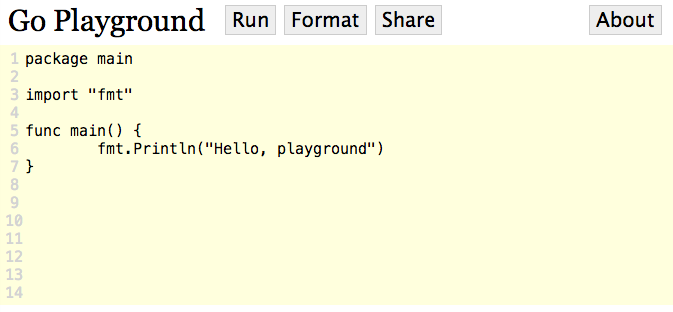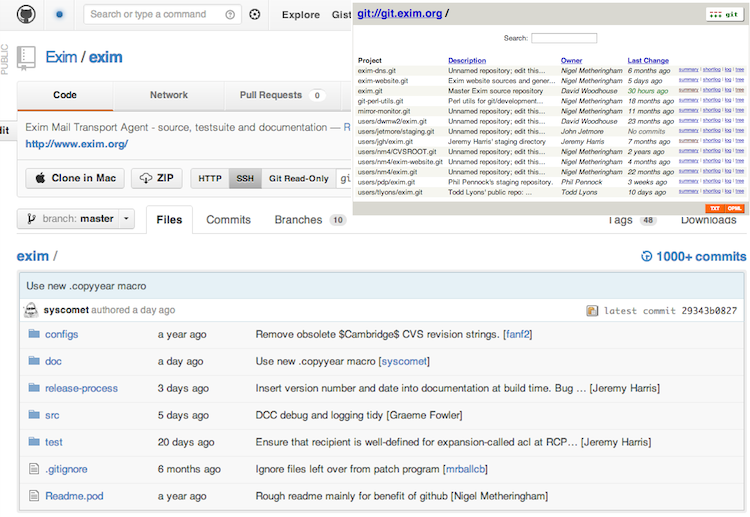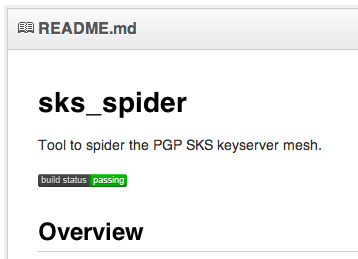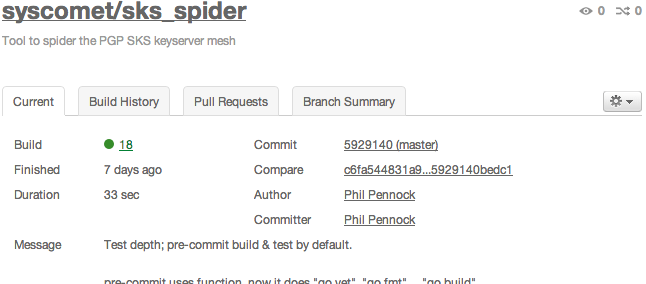GoSF
Quick Intro to using Public Tools with Go
Phil Pennock, Apcera Inc.
Viewable online at http://gosftalk.grumpy-troll.org/
Source repo available on GitHub as https://github.com/syscomet/talk-gosf-2013feb/
Video of talk (second speaker) on Youtube
Nomenclature:
- Go Programming Language.
- Golang — used for disambiguation, in #tags, etc; eg: Twitter #golang
- “Go” for short, in context.
(This presentation made with Landslide.)

Presenter Notes
Twenty minutes, so will go quite quickly, but given how established the GoSF group is, I think folks can handle it readily enough.
Cover git, GitHub, Travis for Continuous Integration, web hooks, git hooks, and some bits about the build and test frameworks.
Slides as reference, will go quickly
If I start reading out each slide in a monotone then stop me.
Presenter Notes
The slides will be available as reference material.
Go Docs & Playground
Most Go presentations seem to reference various features provided by the Go project itself. We'll keep that to just this slide.
You should definitely know about the online documentation, a production running instance of godoc.
- Run
godoc -http=:6060and point a web-browser at http://localhost:6060/ - Or just go to http://golang.org/
The main other tool you should get in the habit of using is the Go Playground
- http://play.golang.org/
- Lets you type code in the browser, run it, share links to it.
Please:
- Learning Go: http://tour.golang.org/ is a great tutorial
Presenter Notes
Getting the core bits tied to the language itself out of the way; if you don't know these, start here.
Okay, a second slide

Presenter Notes
Treat is as your REPL. Aaand on we go.
Directory Layout
Boring
Much like $PATH or $CLASSPATH, building go code uses $GOPATH. On
Unix-like systems, that's a colon-separated list of dirs. On Windows,
semi-colons are used. Unlike $PATH, Go uses a fixed layout within each entry.
Run ls $(go env GOROOT) to see the system code. Pick a place to anchor your
main work. I use ~/src/go. So code I write is in ~/src/go/src/....
Libraries installed with go install go into ~/src/go/pkg/$GOOS_$GOARCH/,
commands into ~/src/go/bin/.
If you're writing code that deals with checking stuff out automatically, please
do allow for multiple entries and take just the first element in the list. In
shell, that's ${GOPATH%%:*}.
Presenter Notes
$GOPATH affects where code lives. You need to take the time to understand this.
Automatic Fetching
Interesting
Much more interesting, go get, go install, etc can understand if an import
path has a hostname embedded in it and grok how to auto-fetch code, including
dependencies, recursively. So if you can build entirely using Go project build
rules, everything needed to build can be fetched, if not already present, just
with go install site.tld/top/level/cmd.
The details are documented at: http://golang.org/doc/code.html#remote
This affects how you write the code:
1 2 3 4 5 | package main
import "github.com/syscomet/namespace_test"
func main() {
namespace_test.Demonstration("Go Steel Programmers")
}
|
Downside: hosting site is in the source code. But the prefix parts of the path
are not part of the code namespace, even without using a renaming import. Thus
namespace_test. and the only parts to change are the import lines.
Presenter Notes
Should you use go get / go build?
- Simple projects
- Open Source Projects
- Getting started, absolutely
- Scaling issues; breaks relative imports, very tied into hosting provider
- Ties into the suitability of
go build -
Simplicity is a virtue, especially when it's time to move away
-
For this talk, yes.
Presenter Notes
An opinion which might inflame.
There is always a trade-off in build-systems between simplicity and power. Often, eg in Java, folks start with something simple because they don't need the power. Then they make a few tweaks, just to add the one little bit needed. By the time they switch to something more powerful, they have a huge tangled mess to deal with.
Go gets around this: it supplies a simple system with no configuration files,
which handles many basic cases but doesn't let you invest effort into creating
a tangled mess. By the time you're ready to move past go build, you know what
you need, you know what to look for, and can choose a build framework to suit.
Porting is simple, because there's just the standard rules.
Telling that Google talks have mentioned google/ as their namespace, which does
not use automatic fetching.
Git
That was a code fetch using a version control system. Go supports several. It doesn't matter much which you use, but Git is currently the In Thing with wide support and some nice features.
It doesn't matter too much which version control system you use, as long as Go supports it.
Beware: Git also has horribly bad default command-line commands (the "porcelain"), with an attitude of "just write porcelain which does what you want", combining with traditional geek macho, to keep the default commands complicated and confusing until you get used to them.
It's powerful, it's good, but don't try learning Git all at once and accept that you'll learn it in bits and pieces.
Git further reading:
git help tutorialgit help tutorial-2git help gitcore-tutorial- http://www-cs-students.stanford.edu/~blynn/gitmagic/
Presenter Notes
Git Tools
-
git instaweb— runs a web-server wrapper aroundgitweb.cgiand points a browser at it, for browsing the repo.1 2 3 4 5
[browser "firefox"] path = /Applications/Firefox.app/Contents/MacOS/firefox [instaweb] local = true browser = firefox
-
Storing password credentials in OSX keychain, or other native password management, is worthwhile to set up.
1 2
[credential] helper = osxkeychain
-
Passphrase-based SSH with ssh-agent is your friend; set the public keys for the services you want to access.
Presenter Notes
You should do these things to Git if you haven't already done so; git instaweb
fires up a web-browser talking to an ad-hoc web-server, showing the gitweb.cgi
view of the current repository.
Credential helpers rock.
Distributed Version Control
Basic revision control lets you check in files, check them out, check in changes, and look back to get the content at any previous point in time, generating diffs as wanted. Where you check them into might be a sub-directory (SCCS, RCS), a central server, or "anywhere".
In place of a mandatory central server, DVCS have a model where folks don't normally retrieve just the most recent version. Instead, they keep a local copy of the entire history so that most operations are local.
The content can then be reconciled between instances, on the same host or remotely, over HTTP, SSH or other stuff, depending upon the DVCS.
Once you have this, you can choose to make some location canonical, or preferred, particularly if it provides useful additional tools.
Presenter Notes
Distributed version control: no imposed authority, only the authority you choose to submit to.
If you stick with the default build system, then yes, you've chosen to make some location canonical.
Exim (not Go)
Exim uses Git, the canonical store is on git.exim.org. But we also use GitHub, https://github.com/Exim/exim. Pushes to the canonical store are automatically pushed to GitHub.

Presenter Notes
As an example of this distributed nature, Exim has its own canonical location, and uses GitHub for some hooks (covered later). The image in the top-right is gitweb on the canonical server, the main image is the GitHub mirror.
GitHub
I'm using GitHub for this talk. I don't work for them. But they're decent and there's a reason I'm using them as the example, and that my employer uses them and an Open Source project I'm involved with increasingly uses them.
There are a few sites providing Git hosting with augmented tools. Currently, probably the most popular is GitHub. Free unlimited hosting for public repositories, my employer is a customer of the private repository support.
At a low level, the most important thing provided is a production-quality staffed Git hosting facility, available over a couple of protocols, with decent authentication infrastructure.
On top of that, are some decent sharing tools for choosing who gets commit access, some adequate light code review and bug-tracking systems (optional), wiki hosting, site hosting for simple static sites which are git checkouts.
And then the magic: hooks
Presenter Notes
Pretty darned solid git hosting, for a price that's right for open source, professionally backed, with nice custom tools that can be addictive. If you haven't used their lightweight code review and issue tracking systems, you really should take a look. The checkbox feature on the issues system is one of their great recent additions.
Biggest downside: issues aren't themselves available as a git repo, AFAICT.
GitHub Hooks
Post commit details to IRC, trigger regression tests, update bug-tracking systems …
A webhook, fundamentally, is “take some data representing an event, POST it to a URL, and perhaps take action based on the response code”.
Add authorisation tokens that can be embedded in a URL, and a standard encoding format (typically JSON) and you're getting somewhere.
Add in a protocol translator site, taking site A's event and changing it to something understood by site B and you have something powerful. Provide a library of those translations as part of the generating site and you can:
- talk natively to a wide variety of sites with very simple template values supplied
- generate the data to let folks plug code into any other site.
https://github.com/$account/$project/admin/hooks Eg: https://github.com/syscomet/sks_spider/admin/hooks
Presenter Notes
Webhooks are powerful and your friend, as is having a common language so that at most you need to do some minor data model munging to glue two systems together.
Going into a little more detail: something has happened, you POST about it, don't care about what happens on the remote side. IRC notifications, Android/iOS, continuous integration and more.
Example project: sks_spider
Don't worry about it. Code was a weekend migration hack, is pretty ugly in places.
This is just some code I wrote, rewriting a Python WSGI app to be a Golang HTTP server; in the process, it became faster and more responsive, using less CPU and less RAM. I'm using it as an example because it's on GitHub, has tests, and is using Travis CI for Continuous Integration testing.
Not relevant, but context: PGP keyservers hold public keys, this maps the peering meshes for statistics and building DNS pools. See http://sks.spodhuis.org/sks-peers if you really care.
Presenter Notes
Seriously, don't worry about what the code does, it's just a suitable demo.
Waffle re PGP keyservers if folks are interested; public keys & signatures in WoT; SKS, written oCaml, reconciliation; peering, peering mesh. sks_spider walks the mesh, checking status, counting keys, lets public pools of servers be published in DNS. This is a research/exploration project, not the code used for the main public pool, but has influenced that code in friendly competition.
Downside to sks_spider
I used a btree project which was written using the gotgo preprocessor to support templates. It's powerful and pleasant, but not at all supported by the normal build system.
Downside: normal build process doesn't work
Upside: I get to show a bit more about Travis configuration
Presenter Notes
Code generation is an example of the limited power of the default build system.
That it happens to be gotgo in this case is irrelevant, it could as well be
go tool yacc.
go test
The Go build system will skip files with names matching *_test.go when
creating a library or binary; instead, the go test command takes those files
and combines them into a test binary, supplying func main() itself.
Functions with signatures matching func TestFoo(t *testing.T) for some Foo
will be candidates for running in a test.
The sks_spider program currently has too few tests, but it has some: Go makes
it easy and I'm gradually building them up.
% go test -v github.com/syscomet/sks_spider
=== RUN TestCountrySpodhuis
--- PASS: TestCountrySpodhuis (0.01 seconds)
=== RUN TestCountrySets
--- PASS: TestCountrySets (0.00 seconds)
countries_test.go:80: Countryset OK: NL,UK,US
=== RUN TestDepthSnapshot
--- PASS: TestDepthSnapshot (0.02 seconds)
depth_test.go:55: Depth OK; 84 entries, max distance 3
PASS
ok github.com/syscomet/sks_spider 0.048s
Presenter Notes
A build system which provides for documentation and tests as part of it, is a nice
low bar to set for the competition. Use it, take advantage of it, don't give this
up if you move away. You don't get to control main() for tests, you just get to
create stand-alone units that plug in.
Test or Check
- http://labix.org/gocheck:
gocheckis, I'm told, a better testing framework for apps:
The Go language provides an internal testing library, named testing, which is relatively slim due to the fact that the standard library correctness by itself is verified using it. The gocheck package, on the other hand, expects the standard library from Go to be working correctly, and builds on it to offer a richer testing framework for libraries and applications to use.
Presenter Notes
Using go test as a base, go check is worth looking at.
The same person who recommended it to me has gone back to mostly using go
test, because it's "just there".
Digression: test what, where?
If you keep your tests in the same directory:
- In namespace
- Get to test the internals
If you put tests in a sub-directory:
- Need to know absolute import path to reach normal code
- Get to test as a client would, so
Example*()tests look like real client code - You unit-test the presented API, not details
Both are useful.
Presenter Notes
There are two approaches to where to place tests. They both have use and it can make sense to use both. If in the same directory, you're inside the package. If in a sub-directory, you import as per normal, so your API-documenting Example* tests use the code just as the client would; in these tests, you're checking the API, the what. In-package, you're testing the how and that the how works.
Continuous Integration
Loosely: every time you push a change to the repository, it triggers a CI system to fetch the code, build it, run the tests and report the results. When it generates a status badge, you can include that badge into even README.md files to provide a convenient status report. APIs will let you build more comprehensive dashboards.
https://travis-ci.org/syscomet/sks_spider

My employer pays for Travis, they've been very responsive with Golang issues, we're happy. Free public service covers Go too (and is what sks_spider uses).
Presenter Notes
Continuous Integration is worth doing, always. Travis is free for open source projects and has a commercial offering, they support Go. The biggest competition is probably self-hosting Jenkins.
Continuous Integration: every time (by default) that you push a change, the code gets rebuilt and the tests run.
Travis CI
Two ways to configure the pairing GitHub ⇆ Travis link:
- Step through the process carefully, it's documented
- Grant Travis CI (via OAuth) permission to make the changes to your GitHub repo for you.
It basically boils down to generating a token on the Travis site, and configuring a commit hook on GitHub. Since it's a public repository, there's no auth required to fetch the content. Things are more involved for private repositories. Then, by default, pushes will trigger a test. That simple?

Presenter Notes
If you're working with a public repo, just tell Travis to make the changes; it's git, you have copies, you can always revert. The private repo method is evolving and becoming simpler, and I won't go into it here.
If you do need to set things up manually, the link in this slide will take you to the correct part of the docs.
.travis.yml
Okay, you need to tell Travis how to test your project. Most simply:
1 | language: go
|
That's it. Because Go has a built-in test framework, that's normally all that's needed.
The configuration is in YAML and the most relevant additional top-level keys
are script and install, each of which can be a list of multiple steps.
In Travis, the steps are combined into shell input, so you can set variables in earlier steps and use them in later steps.
Used to be correct for Automatic Fetching, they'll fix it; for Go, Travis will
create ~/gopath/src and export GOPATH=~/gopath and go get paths work, but
by default layout for current repo is not presently inside $GOPATH. ☹
The content is pulled as a git checkout of the version that triggered a commit,
linked into place, and your current working directory is inside your project
dir, so that you can access data/ files with relative paths. Next slide
shows fixups.
Presenter Notes
The configuration file is simple YAML; this talk is badly timed for Travis, they recently pushed something unfortunate, they're fixing it.
A better .travis.yml
1 2 3 4 5 | language: go
script:
- go vet
- go test -v
|
The go vet command will catch things like .Printf() calls with mismatches in
%-expandos against the supplied arguments. I've not seen a false positive yet,
thus so far I consider it a test failure if go vet complains.
Use travis-lint
Presenter Notes
Use travis-lint. go vet is nice.
.travis.yml with install location fixups
Hopefully not needed by the time you try this.
1 2 3 4 5 6 7 8 9 10 11 12 13 | language: go
install:
- CANONICAL="github.com/username/frobozz"
- here=$(/bin/pwd -P)
- TOP="${GOPATH%%:*}/src"
- "if ! [ -d \"$TOP/$CANONICAL\" ]; then ⏎
mkdir -pv \"$TOP/$(dirname $CANONICAL)\" ⏎
&& ln -s \"$here\" \"$TOP/$CANONICAL\"; fi"
- cd \"$TOP/$CANONICAL\"
- go get -d -v
- go build -v frobozz.go
- go test -i
|
[The ⏎ is purely to mark slide-fitting linebreaks you should skip]
Presenter Notes
sks_spider .travis.yml
This is the complexity you create for yourself by breaking out of pure Go build
compatibility. You probably want to move most of the work into an install.sh
script, or something using your build framework.
1 2 3 4 5 6 7 8 9 10 11 12 13 14 15 16 17 18 | language: go
install:
- repo_dir=$(/bin/pwd -P)
- spider_parent="github.com/syscomet"
- SPIDER_DIR="github.com/syscomet/sks_spider"
- BTREE_DIR="github.com/runningwild/go-btree"
- GOTGO_DIR="github.com/droundy/gotgo/gotgo"
- CHECKOUT_TOP="${GOPATH%%:*}/src"
- "if ! [ -d \"$CHECKOUT_TOP/$spider_parent\" ]; then mkdir -pv \"$CHECKOUT_TOP/$spider_parent\" && ln -s \"$repo_dir\" \"$CHECKOUT_TOP/$SPIDER_DIR\"; fi"
- go get -fix -d -v "$BTREE_DIR"
- "( cd \"$CHECKOUT_TOP/$BTREE_DIR\" && rm bench.go test.go )"
- go get -d "$GOTGO_DIR"
- go build -v "$GOTGO_DIR"
- ./gotgo -o "$CHECKOUT_TOP/$BTREE_DIR/btree.go" "$CHECKOUT_TOP/$BTREE_DIR/btree.got" string
- go get -d -v
- go build -v sks_stats_daemon.go
- go test -i
|
Presenter Notes
Too hot! Too cold!
By default, Travis runs on every commit. This is good when your first commits
to get Travis working are on a travis_setup branch.
Quickly, you get to where you want commits, say, only on the main branch and on
pull requests. Configure it, and it shall be so.
This too goes in .travis.yml.
Magic phrase in commit message: [ci skip]
Recent addition: easy UI to force a retry when something failed because of a transient glitch (eg, fetch from GitHub failed).

Presenter Notes
Example skip commit
commit 796ceba300fd8d88064808220e070a243d15036f
Author: Phil Pennock <pdp@spodhuis.org>
Date: Sun Jan 20 01:11:30 2013 -0500
Copyright year updates.
vi $(git whatchanged --since=2013-01-01 | grep '^:100' | ⏎
sed 's/^[^M]*M//' | sort -u )
[ci skip]
Presenter Notes
Git pre-commit
You can't run your own code on GitHub to verify a push. It's not your service and the security implications would be awkward. If you run your own central repository, you can do this.
You can run pre-commit scripts to check before you even commit into your local repository. But beware that the pre-commit scripts are not natively part of the repository, because you shouldn't be running arbitrary unseen code when you run a local git command whenever you pull content.
So $repo/.git/hooks/pre-commit will need to be manually created when you set
up your checkout.
A good approach is to keep a collection of trusted pre-commit scripts in a repo.
A trusting approach is to create git-hooks/ within your repo and create
pre-commit as a symlink pointing to ../../git-hooks/pre-commit — instant
security hole, if anyone else can commit.
https://github.com/syscomet/sks_spider/blob/master/git-hooks/pre-commit
Presenter Notes
Done this with sks_spider for demonstration purposes and to provide a reference; hopefully will remember to remove should I ever grant someone else push access.
Pre-commit steps
- Use
foo=$(git config hooks.foo)to grab any config items from$repo/.git/config - The content in the working directory at the time is not the content being
committed; you need to ensure that what you test is what's part of the commit.
- git stash --keep-index --all --quiet
- git reset --hard --quiet; git stash pop --index --quiet
- We run the first two of these by default, the second two only if asked:
- go vet
- go fmt -l -e $File
- go build
- go test
Further, additional build targets can be added, to exercise the package main
wrappers.
BSD license on sks_spider pre-commit and is a good place to start.
Presenter Notes
Fin
Will be linked to from the meetup page.
© 2012, 2013 Apcera, Inc.
 This work is licensed under a
Creative Commons Attribution 3.0 United States License.
This work is licensed under a
Creative Commons Attribution 3.0 United States License.